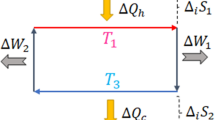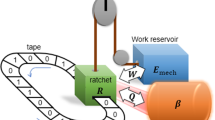Abstract
In many assembly line processes like metabolic and signaling networks in biological systems, the products of the first enzyme are the reactant for the next enzyme in the network. Working of multiple machines leads to efficient utilization of resources. Motivated by this, we investigate if multiple Maxwell demons lead to more efficient information processing. We study the phase space of multiple demons acting on an information tape based on the model of Mandal and Jarzynski [1, 2]. Their model is analytically solvable and the phase space of the device has three regions: engine, where work is delivered by writing information to the tape, erasure, where work is performed on the device to erase information on the tape, and dud, when work is performed and, at the same time, the information is written to the tape. For identical demons, we find that the erasure region increases at the expense of the dud region, while the information engine region does not change appreciably. The efficiency of the multiple demon device increases with the number of demons in the device and saturates to the equilibrium (maximum) efficiency even at short cycle times for very large numbers of demons. By investigating a device with non-identical demons acting on a tape, we identify the demon parameters that control the different regions of the phase space. Our model is well suited to study information processing in assembly line systems.
Graphical abstract









Similar content being viewed by others
Data availability statement
This manuscript has no associated data or the data will not be deposited. [Authors’ comment: The datasets generated during and/or analysed during the current study are available from the corresponding author on reasonable request.]
References
D. Mandal, C. Jarzynski, Work and information processing in a solvable model of maxwell’s demon. Proc. Natl. Acad. Sci. 109(29), 11641–11645 (2012)
D. Mandal, H. Quan, C. Jarzynski, Maxwell’s refrigerator: an exactly solvable model. Phys. Rev. Lett. 111(3), 030602 (2013)
J.C. Maxwell, Theory of heat (london (Longmans, UK, 1871)
L. Szilard, Über die entropieverminderung in einem thermodynamischen system bei eingriffen intelligenter wesen. Z. Phys. 53(11), 840–856 (1929)
R. Landauer, Irreversibility and heat generation in the computing process. IBM J. Res. Dev. 5(3), 183–191 (1961)
K. Proesmans, J. Ehrich, J. Bechhoefer, Finite-time landauer principle. Phys. Rev. Lett. 125, 100602 (2020). https://doi.org/10.1103/PhysRevLett.125.100602
M. Esposito, C. Van den Broeck, Second law and landauer principle far from equilibrium. EPL (Europhysics Letters) 95(4), 40004 (2011)
C.H. Bennett, The thermodynamics of computation-a review. Int. J. Theor. Phys. 21(12), 905–940 (1982)
R.P. Feynman, T. Hey, R.W. Allen, Feynman Lectures on Computation. CRC Press, ??? (2018)
O. Penrose, Foundations of Statistical Mechanics: a Deductive Treatment. Courier Corporation, (2005)
T. Sagawa, M. Ueda, Generalized jarzynski equality under nonequilibrium feedback control. Phys. Rev. Lett. 104(9), 090602 (2010)
J.M. Parrondo, J.M. Horowitz, T. Sagawa, Thermodynamics of information. Nat. Phys. 11(2), 131–139 (2015)
D. Abreu, U. Seifert, Extracting work from a single heat bath through feedback. EPL (Europhysics Letters) 94(1), 10001 (2011)
D. Abreu, U. Seifert, Thermodynamics of genuine nonequilibrium states under feedback control. Phys. Rev. Lett. 108(3), 030601 (2012)
J.M. Horowitz, M. Esposito, Thermodynamics with continuous information flow. Phys. Rev. X 4(3), 031015 (2014)
U. Seifert, Stochastic thermodynamics, fluctuation theorems and molecular machines. Rep. Prog. Phys. 75(12), 126001 (2012)
Y. Cao, Z. Gong, H. Quan, Thermodynamics of information processing based on enzyme kinetics: An exactly solvable model of an information pump. Phys. Rev. E 91(6), 062117 (2015)
A. Barato, U. Seifert, Unifying three perspectives on information processing in stochastic thermodynamics. Phys. Rev. Lett. 112(9), 090601 (2014)
J.M. Horowitz, T. Sagawa, J.M. Parrondo, Imitating chemical motors with optimal information motors. Phys. Rev. Lett. 111(1), 010602 (2013)
F.J. Cao, M. Feito, Thermodynamics of feedback controlled systems. Phys. Rev. E 79(4), 041118 (2009)
F.J. Cao, L. Dinis, J.M. Parrondo, Feedback control in a collective flashing ratchet. Phys. Rev. Lett. 93(4), 040603 (2004)
M. Ponmurugan, Generalized detailed fluctuation theorem under nonequilibrium feedback control. Phys. Rev. E 82(3), 031129 (2010)
J.M. Horowitz, J.M. Parrondo, Thermodynamic reversibility in feedback processes. EPL (Europhysics Letters) 95(1), 10005 (2011)
A. Kundu, Nonequilibrium fluctuation theorem for systems under discrete and continuous feedback control. Phys. Rev. E 86(2), 021107 (2012)
A.C. Barato, U. Seifert, An autonomous and reversible maxwell’s demon. EPL (Europhysics Letters) 101(6), 60001 (2013)
R. Kawai, J.M. Parrondo, C. Van den Broeck, Dissipation: The phase-space perspective. Phys. Rev. Lett. 98(8), 080602 (2007)
J.M. Horowitz, S. Vaikuntanathan, Nonequilibrium detailed fluctuation theorem for repeated discrete feedback. Phys. Rev. E 82(6), 061120 (2010)
S. Toyabe, T. Sagawa, M. Ueda, E. Muneyuki, M. Sano, Experimental demonstration of information-to-energy conversion and validation of the generalized jarzynski equality. Nat. Phys. 6(12), 988–992 (2010)
J.V. Koski, V.F. Maisi, J.P. Pekola, D.V. Averin, Experimental realization of a szilard engine with a single electron. Proc. Natl. Acad. Sci. 111(38), 13786–13789 (2014)
G. Paneru, D.Y. Lee, T. Tlusty, H.K. Pak, Lossless brownian information engine. Phys. Rev. Lett. 120(2), 020601 (2018)
G. Paneru, S. Dutta, T. Sagawa, T. Tlusty, H.K. Pak, Efficiency fluctuations and noise induced refrigerator-to-heater transition in information engines. Nat. Commun. 11(1), 1–8 (2020)
G. Paneru, S. Dutta, T. Tlusty, H.K. Pak, Reaching and violating thermodynamic uncertainty bounds in information engines. Phys. Rev. E 102(3), 032126 (2020)
M.c.v. Gavrilov, J. Bechhoefer, Erasure without work in an asymmetric double-well potential. Phys. Rev. Lett. 117, 200601 (2016). https://doi.org/10.1103/PhysRevLett.117.200601
Y. Tu, The nonequilibrium mechanism for ultrasensitivity in a biological switch: Sensing by maxwell’s demons. Proc. Natl. Acad. Sci. 105(33), 11737–11741 (2008)
P. Sartori, L. Granger, C. Lee, J. Horowitz, PLoS Comput. Biol. 10, e1003974 (2014)
S. Ito, T. Sagawa, Maxwell’s demon in biochemical signal transduction with feedback loop. Nat. Commun. 6(1), 1–6 (2015)
D. Andrieux, P. Gaspard, Nonequilibrium generation of information in copolymerization processes. Proc. Natl. Acad. Sci. 105(28), 9516–9521 (2008)
T. Chuan, J. Maillard, K. Modi, T. Paterek, M. Paternostro, M. Piani, Quantum discord bounds the amount of distributed entanglement. Phys. Rev. Lett. 109(7), 070501 (2012)
K. Jacobs, Quantum measurement and the first law of thermodynamics: The energy cost of measurement is the work value of the acquired information. Phys. Rev. E 86(4), 040106 (2012)
H. Quan, Y. Wang, Y.-X. Liu, C. Sun, F. Nori, Maxwell’s demon assisted thermodynamic cycle in superconducting quantum circuits. Phys. Rev. Lett. 97(18), 180402 (2006)
V. Serreli, C.-F. Lee, E.R. Kay, D.A. Leigh, A molecular information ratchet. Nature 445(7127), 523–527 (2007)
P. Strasberg, G. Schaller, T. Brandes, M. Esposito, Thermodynamics of a physical model implementing a maxwell demon. Phys. Rev. Lett. 110(4), 040601 (2013)
A.B. Boyd, D. Mandal, J.P. Crutchfield, Identifying functional thermodynamics in autonomous maxwellian ratchets. New J. Phys. 18(2), 023049 (2016)
M. Thomas, A.T. Joy, Elements of Information Theory. Wiley-Interscience, (2006)
Acknowledgements
The authors acknowledge Birla Institute of Technology and Science, Pilani for funding the project through Research Initiation Grant (Serial No 189).
Author information
Authors and Affiliations
Contributions
SD conceived and designed the analysis, performed analysis, and wrote the paper.
Corresponding author
Rights and permissions
Springer Nature or its licensor holds exclusive rights to this article under a publishing agreement with the author(s) or other rightsholder(s); author self-archiving of the accepted manuscript version of this article is solely governed by the terms of such publishing agreement and applicable law.
Springer Nature or its licensor holds exclusive rights to this article under a publishing agreement with the author(s) or other rightsholder(s); author self-archiving of the accepted manuscript version of this article is solely governed by the terms of such publishing agreement and applicable law.
About this article
Cite this article
Dutta, S. Thermodynamics of multiple Maxwell demons. Eur. Phys. J. B 95, 131 (2022). https://doi.org/10.1140/epjb/s10051-022-00394-x
Received:
Accepted:
Published:
DOI: https://doi.org/10.1140/epjb/s10051-022-00394-x




